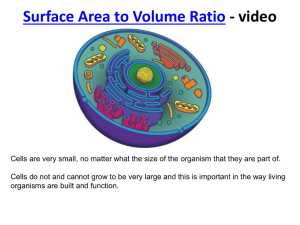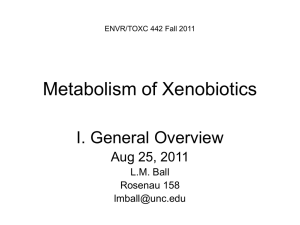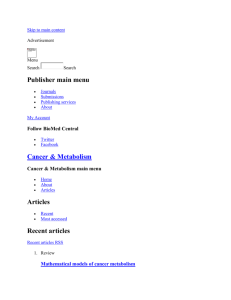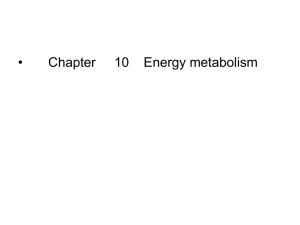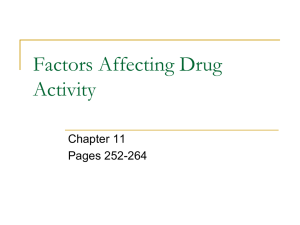Metabolism and the Influence of Temperature
advertisement
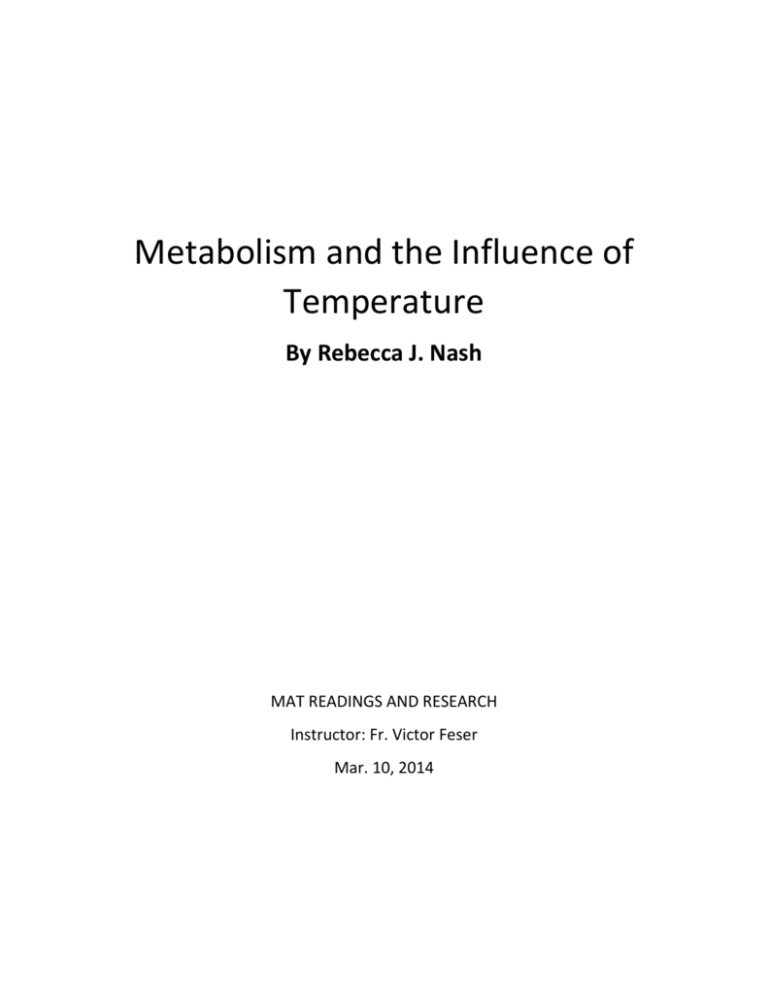
Metabolism and the Influence of Temperature By Rebecca J. Nash MAT READINGS AND RESEARCH Instructor: Fr. Victor Feser Mar. 10, 2014 Nash |1 Metabolism is how your body converts food into fuel for your body. It is referred to most often when people consider how to lose weight. Metabolism affects how much food is used as fuel and how much is kept on the body turned into fat.1 There are many variables such as age, species, temperature, diet, body mass index, and other factors that influence an individual’s metabolism rate. These variables make it very difficult to analyze a specific formula for calculating metabolism. Many people disagree on what variables affect metabolism and to what extent each variable plays a part in the metabolism. One equation to determine metabolism is Q b0 M 3/4e ElkT 2 where Q is the metabolic rate, M is the body mass, E is the activation energy of the metabolism, T is the absolute temperature, k is the Boltzmann’s constant (1.3806488 × 10-23 m2 kg s-2 K-1) which relates energy with temperature, and b0 is a normalization constant independent of body mass and temperature. At first glance, this equation seems to be a complicated jumble of the different variables related to metabolism. In analyzing this equation, it is best to separate the equation into parts. ElkT The first part to be considered is the e variable. This unit connects activation energy of metabolism with the Boltzmann’s constant and the absolute temperature. We multiple the absolute temperature by the Boltzmann’s constant which determines the energy created with this temperature. Then that is multiplied by the activation energy of metabolism to show the metabolism occurred at this temperature based on the energy given at this 1 2 (Weight Loss and Diet Plans: Metabolism Directory, n.d.) (Clarke, 2004) Nash |2 temperature. Taking e to the negative value of this creates what is known as the Boltzmann factor. Therefore, this Boltzmann’s factor connects an individual’s activation energy of metabolism with the temperature that the individual is subjected to. The rest of the equation is the normalization constant multiplied by the body mass of the individual to the power of 3/4ths. Therefore, looking at the equation in this perspective shows that we are multiplying the individual’s ability to process energy at certain temperatures by the individual’s body mass and by a normalization constant to keep the values reasonable over various temperatures, body mass, and activation energies. This makes the equation a lot easier to interpret. This is not the only way to interpret metabolic rate though. Some believe that metabolism is more accurately represented as a difference in 10 M T1 T2 3 temperature causing a difference in metabolism. A formula showing this is Q10 2 M1 where Q10 is the ratio of the difference in metabolism associated with a 10 degree (Celsius) shift. The M represents the metabolic rate at two times and the T represents the temperatures at two difference times. This equation provides less information than the previous, for in order for it to work, there must be data on the metabolic rates at at least two different temperatures. The similarity between these two equations is they focus hugely on the effects of temperature change on an individual’s metabolism. If we knew the Q10 value, we could solve T2 T1 10 the second equation to be M 2 M1Q10 3 (Jose Guilherme Chaui-Berlinck, 2002) . Therefore if we know the Q10 ratio, we can Nash |3 estimate a temperature change by raising Q10 to the temperature difference over ten (because ten is increment of temperature difference the Q10 estimates) and multiply that by the initial metabolism. The second equation sees the difference between temperature and metabolism as a simple exponential correlation of every ten degrees. The first equation views metabolism as a complicated process closely related to body mass the activation rate of converting energy and temperature. With the second equation representing metabolism as a ratio of temperature difference, it ignores the body mass and activation energy for within a species, the values for these variables should stay consistent. Therefore, these equations can be used hand-in hand to use the first equation to determine metabolism at two or more temperatures and then inputting these values into the second equation to see a specific exponential equation. Perhaps the most applicable use of analyzing the difference in metabolism from a difference in temperature is predicting animal behavior as the seasons change. The University of New Hampshire studied how the changing seasons would affect the metabolism of several bobcats.4 For their study, they had 4 bobcats, 2 males and 2 females. They kept the bobcats for the year 1982-1983. They were housed, caged, and fed according to their regular diet. To analyze how the seasons affected the bobcats, they would fast the bobcats in the middle of each season and record the metabolic rates of the bobcats during their days of fasting. The average of the recorded days for each season was said to be the seasonal standard metabolic rate. 4 (William W. Mautz, 1989) Nash |4 The results found were that the seasonal standard metabolic rates were 88 for summer, 75 for fall, 85 for winter, and 69 for spring. This data shows that the lowest temperatures (winter) and the highest temperatures (summer) provide higher metabolic rates than the spring and fall temperatures. The relationship here can be viewed as almost a parabola where the vertex sits at the average temperature that the bobcats are exposed to while lower and higher temperatures result in higher metabolic rates. At first this would seem to disprove our previous equations for our equations do not take into account a base temperature that an individual typically experiences. The bobcat experiment shows in part that as the temperature changes to the cold or warm extremes, the metabolic rate goes up whether the temperature goes up or down. The graph here was given in the University of New Hampshire’s paper showing a trend similar to the equations given earlier. In a given season, the metabolic rate has an exponential relationship to the temperature change. Our official reports show that the average metabolic Nash |5 rate increase as the temperature increases or decreases, but within the seasons, it was found that the higher temperatures resulted in lower metabolism while the lower temperatures result in a higher metabolic rate. This stays consistent to the previous formulas to have an exponential relationship. The false parabolic relationship is caused because of an animal’s temperature regulation. By growing a thinner coat of fur in the summer, the animal maintains a higher metabolism rate because they do not gather as much heat from the higher temperatures as they do when they have a heavier winter coat. The previous formulas do not account well enough for an animal’s temperature regulation abilities and thus temperatures affect them differently in different seasons due to their thicker or thinner coats of fur. In conclusion, metabolism relies on many variables of a creature’s lifestyle and body. It is best represented as a linear relationship where the higher the temperatures, the lower the metabolic rate. These formulas do not take into account the thermoregulatory behaviors of many animals though, and as such, the multitude of variables has not led to a specific accurate formula for all metabolic rates. Nash |6 References Clarke, A. (2004, Apr.). Is there a Universal Temperature Dependence of Metabolism. Functional Ecology, 18(2), 252-256. Retrieved Mar. 2, 2014 Jose Guilherme Chaui-Berlinck, L. H. (2002, Jan. 7). Tempurature Effects on Energy Metabolism: A Dynamic System Analysis. Proceedings: Biological Sciences, 269(1486), 15-19. Retrieved Mar. 2, 2014 Weight Loss and Diet Plans: Metabolism Directory. (n.d.). Retrieved Mar. 5, 2014, from WebMD: http://www.webmd.com/diet/metabolism-directory William W. Mautz, P. J. (1989, Jan.). Metabolic Rate of Bobcats as Influenced by Seasonal Tempuratures. The Journal of Wildlife Management, 53(1), 202-205. Retrieved Mar. 2, 2014


